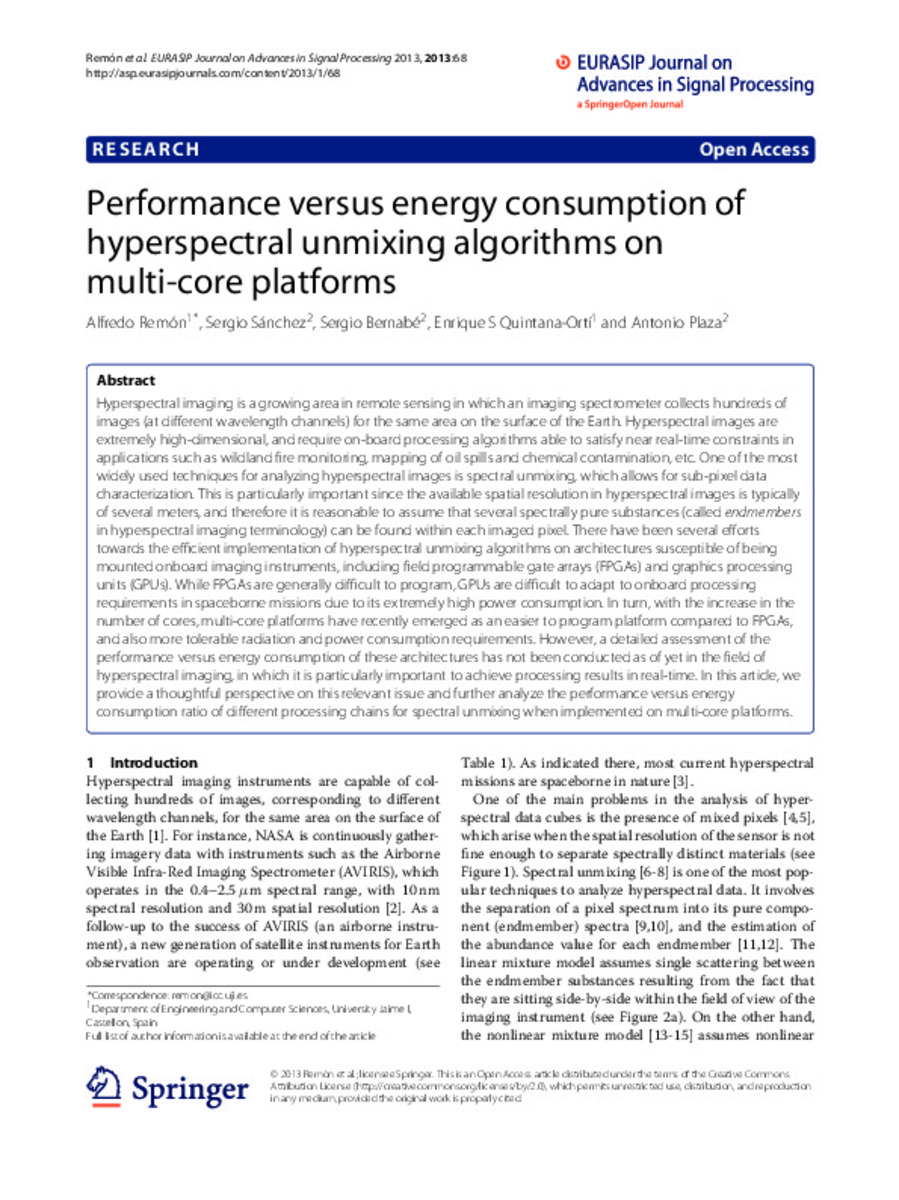Mostrar el registro sencillo del ítem
Performance versus energy consumption of hyperspectral unmixing algorithms on multi-core platforms
| dc.contributor.author | Remón Gómez, Alfredo | |
| dc.contributor.author | Sánchez, Sergio | |
| dc.contributor.author | Bernabé, Sergio | |
| dc.contributor.author | Quintana-Orti, Enrique S. | |
| dc.contributor.author | Plaza, Antonio | |
| dc.date.accessioned | 2014-03-03T19:56:04Z | |
| dc.date.available | 2014-03-03T19:56:04Z | |
| dc.date.issued | 2013 | |
| dc.identifier.citation | EURASIP Journal on Advances in Signal Processing 2013, 2013:68 | ca_CA |
| dc.identifier.issn | 1687-6172 | |
| dc.identifier.issn | 1687-6180 | |
| dc.identifier.uri | http://hdl.handle.net/10234/85170 | |
| dc.description.abstract | Hyperspectral imaging is a growing area in remote sensing in which an imaging spectrometer collects hundreds of images (at different wavelength channels) for the same area on the surface of the Earth. Hyperspectral images are extremely high-dimensional, and require on-board processing algorithms able to satisfy near real-time constraints in applications such as wildland fire monitoring, mapping of oil spills and chemical contamination, etc. One of the most widely used techniques for analyzing hyperspectral images is spectral unmixing, which allows for sub-pixel data characterization. This is particularly important since the available spatial resolution in hyperspectral images is typically of several meters, and therefore it is reasonable to assume that several spectrally pure substances (called endmembers in hyperspectral imaging terminology) can be found within each imaged pixel. There have been several efforts towards the efficient implementation of hyperspectral unmixing algorithms on architectures susceptible of being mounted onboard imaging instruments, including field programmable gate arrays (FPGAs) and graphics processing units (GPUs). While FPGAs are generally difficult to program, GPUs are difficult to adapt to onboard processing requirements in spaceborne missions due to its extremely high power consumption. In turn, with the increase in the number of cores, multi-core platforms have recently emerged as an easier to program platform compared to FPGAs, and also more tolerable radiation and power consumption requirements. However, a detailed assessment of the performance versus energy consumption of these architectures has not been conducted as of yet in the field of hyperspectral imaging, in which it is particularly important to achieve processing results in real-time. In this article, we provide a thoughtful perspective on this relevant issue and further analyze the performance versus energy consumption ratio of different processing chains for spectral unmixing when implemented on multi-core platforms. | ca_CA |
| dc.format.extent | 15 p. | ca_CA |
| dc.format.mimetype | application/pdf | ca_CA |
| dc.language.iso | eng | ca_CA |
| dc.publisher | SpringerOpen | ca_CA |
| dc.relation.isPartOf | EURASIP Journal on Advances in Signal Processing 2013, vol. 2013, no 68 | ca_CA |
| dc.rights | © 2014 Springer unless otherwise stated. Part of Springer Science+Business Media. | ca_CA |
| dc.rights | Attribution 4.0 Spain | * |
| dc.rights.uri | http://creativecommons.org/licenses/by-sa/4.0/ | * |
| dc.subject | Hyperspectral images | ca_CA |
| dc.subject | Hyperspectral unmixing algorithms | ca_CA |
| dc.title | Performance versus energy consumption of hyperspectral unmixing algorithms on multi-core platforms | ca_CA |
| dc.type | info:eu-repo/semantics/article | ca_CA |
| dc.identifier.doi | http://dx.doi.org/10.1186/1687-6180-2013-68 | |
| dc.rights.accessRights | info:eu-repo/semantics/openAccess | ca_CA |
| dc.relation.publisherVersion | http://asp.eurasipjournals.com/content/2013/1/68 | ca_CA |
Ficheros en el ítem
Este ítem aparece en la(s) siguiente(s) colección(ones)
-
ICC_Articles [417]








